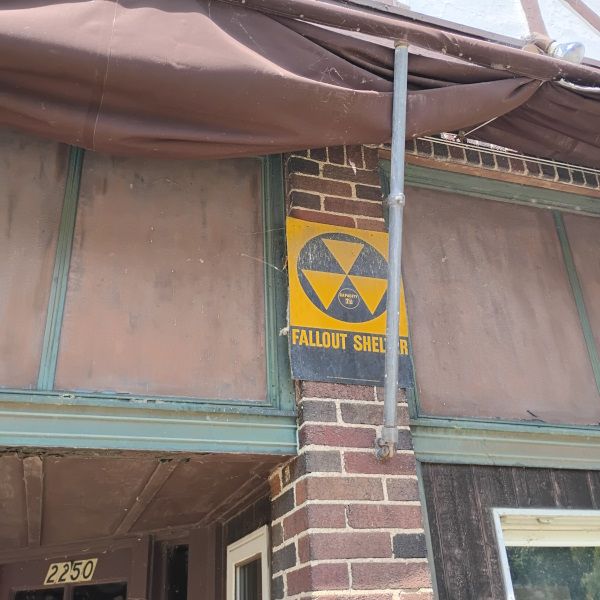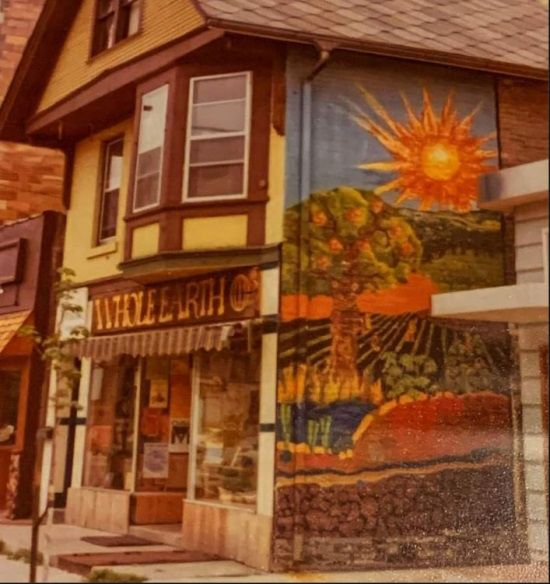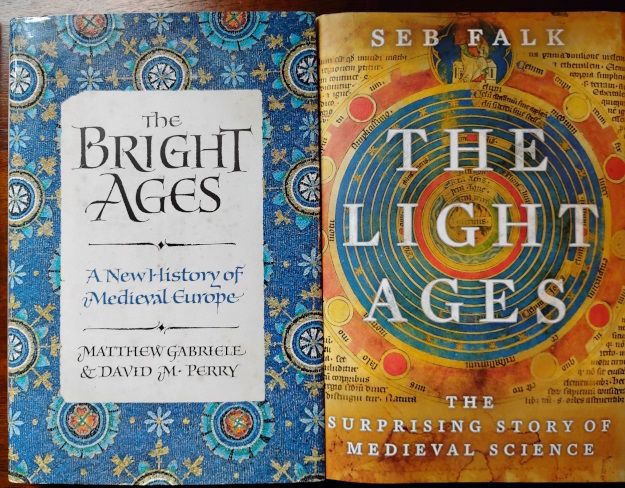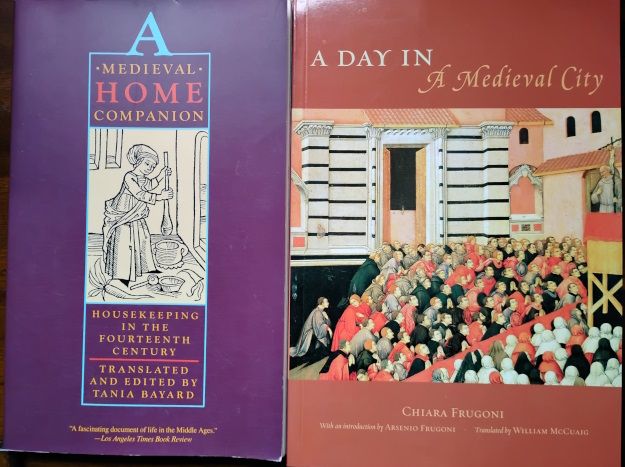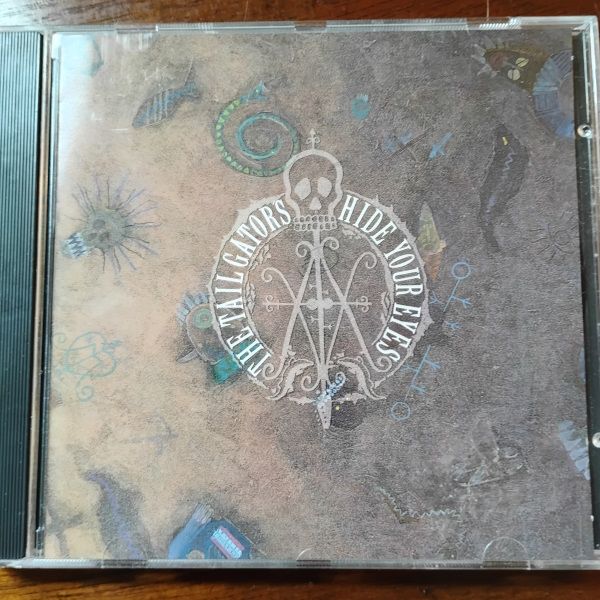Here are the fractional addresses I've found in Madison. What are the criteria for one as opposed to assigning a unit #? The sign with the lighthouse might be Monona but I lean towards it being a Madison address. Also, I have to wonder why so many of these are on Sherman Avenue.
Fearful Symmetries
Witness a machine turn coffee into pointless ramblings...
30 June, 2025
29 June, 2025
Gimme shelter
These are the fallout shelter signs I've seen around town. These Cold War remnants are a rarity these days, unlike during my childhood. The first one may have been removed in the past few years. And the last one I noticed only last week thanks to a raised awning.
Did you ever notice?
Did you ever notice that when you're driving north on Hooker Avenue and you cross Mac Pherson Strasse
that you find yourself on Pleasure Drive?
If this is the recovery capsule, where are the ambassadors?: Ambassadors of Death
Back to the tele!
If I've seen Ambassadors of Death before then it was likely when I was in my early teens on channel 11 in Chicago. Some bits were vaguely familiar but, overall, it felt like a new viewing experience.
It is some point in 1970's future and England has a space program which is run by a Mr. Cornish. He is currently at the program's HQ which I believe was called Space Center. Wait.
I forgot to note the titles/credits. Episode 1 and the rest all begin with an abbreviated title sequence which looks all cleaned up with crisp text that looks shiny and new. We then get a bit of the story. In episodes 2-6 this is a rehash of the previous episode's cliffhanger. Here we see an astronaut on a large screen doing what astronauts do - hang out in a space suit, turn knobs, flick switches, etc. The fellow is chatting with Cornish.
The spaceman is in a recovery capsule heading to meet Mars Probe 7 as mission control has not heard from that ship's crew in 7 months. No one knows if they're alive or dead. In a fit of hope, Cornish says they were alive when Mars Probe 7 took of from the Red Planet. The astronaut grimly replies that "something" took off from Mars.
We then get the second half of the opening credits. The title appears in 2 parts. First
AMBASSADORS OF
Then there's a brief pause before
DEATH
Oooh! Spine tingling stuff!
The mission control set is rather large, though underlit, so it has a rather dark and dreary atmosphere. But that doesn't stop an intrepid reporter from giveing viewers the lowdown on things at Space Center. He goes on to give strategically placed plot summaries for another episode or 2 before disappearing for a spell. Perhaps he goes down to the local pub. Suddenly we cut to a TV screen showing his report with the Doctor glued to the boob tube. He looks to be in a fairly well appointed living room (or is it drawing room?) but the TARDIS console is there. Did I miss a line in the previous TV story? It wasn't clear to me if this was a new, cozier console room or if he had put the console into his UNIT cottage or wherever it is they put him up.
Liz brings him a cup of tea (2 lumps?) and the banter between the two that follows is collegial and friendly. Even, dare I say, warm as their faces smile quite a bit.
The recovery capsule is now preparing to link up with the Mars Probe. These ships are conical and they link up at their tips. We finally get to see the astronaut in the capsule instead of seeing a video feed of him on the big screen at mission control. The music here sounded a bit like "Whiter Shade of Pale". The scene where the capsule's tips come together reminded me of 2001 at first but quickly brought A Movie to mind as the models clumsily moved ever closer.
The astronaut, Charlie, opens his hatch to greet his fellow space travelers when a strange noise is heard. Charlie, his gaping maw pointed at the camera, screams in agony and it looks great because he is upside down. Folks at mission control cover their ears and contort their faces in pain. This scene reminded me of another scene in 2001 - the one where the apemen are looking at the monolith on the Moon when that signal bursts out. The Doc and Liz hear it too through the Philco lo-fi monophonic speaker. It's familiar to the Doctor but he cannot quite place it. Ergo he and his mini-skirted assistant head to mission control.
There the reporter, who always has a deadly serious look on his face, is chatting with Taltalian, a big, tall scientist with a French accent whose demeanor reminded me of Henry Kissinger and whose pants screamed 1960s. Everyone is in a tizzy because contact has been lost with Charlie and no one knows what to make of the ear-piercing signal which has been repeating itself. After the Doctor, Liz, and UNIT arrive, another weird noise is heard which the Doctor surmises is a response to the initial one. A little triangulation later and a London warehouse is identified as the source of the second transmission.
We meet the bad guys at the warehouse sitting before a transmitter. Another chap comes in to alert them to UNIT's presence. They prepare to bail as a big fight ensues below but not before rigging a self-destruct thingy on the presumably highly expensive equipment. At one point the Brig gets into a stand off with a Sergeant Somebody or Other. The sarge gets the upper hand and it appears that the Brigadier's goose is cooked. But a UNIT red shirt who was unconscious behind the villain conveniently wakes up. He takes hold of a cargo hook or something like that and swings it at the sarge's head. But he misses by a miles. His effort was so half-hearted and comically awkward that I think I laughed out loud.
After the raid, the Doc and Liz convince Cornish to let them have some computer time to try and decode the mysterious first signal. They enter the computer room and Taltalian comes up behind them pointing a gun.
Thus ends episode 1 and begins episode 2.
Taltalian wants the reel of tape that the Doctor has that holds a recording of that mysterious signal. At least it wasn't a stack of punch cards. However, the turnlabcoat doesn't get it and flees.
The sarge who was captured at the warehouse and locked up is freed from his cell. An inside job! We learn from Mr. Reporter Man that the capsule is on a return course and is set to land in southern England. It does and our heroes show up with UNIT and a recovery crew. In a dramatic anti-climax, the capsule hatch does not open. The 2 guys from the warehouse who escaped look on with binoculars from a distance.
The capsule is loaded onto a flatbed truck and is taken away escorted by guys on motorcycles. A helicopter appears in the sky and starts throwing grenades at the escorts. It lands and 2 masked gentlemen step out and hijack the truck. But not for long as the Doctor gets wind of what's happened and he devises a plan. He parks Bessie in the middle of the road to impede the truck's progress and fools the hijackers into getting out of the cab to help move the car. The Doc then activates Bessie's anti-theft device and the men find that they cannot pull their hands away from Bessie's maize yellow body. They helplessly look on as the man who tricksied them drives the truck away to safety.
The capsule is finally returned to Space Center but still no contact with the astronauts within. The Brig and Doc go to visit a Sir James, the big wig, to complain about Taltalian. Sir James is the Minister of Space Exploration or some such thing. Anyway, after lodging their complaints, the Brig and Doc leave. Taltalian slithers out from the door behind Sir James...
Back at Space Center Liz is trying to communicate via radio with the inhabitants of the capsule - quite unsuccessfully. Then suddenly she gets a reply. A voice is asking for clearance to land. The message repeats. The Doctor takes the mic and asks a few questions but the message continues to be the same. He forcefully tells Cornish to cut the capsule open. End of episode 2.
I watched part of the accompanying making of documentary and Terrence Dicks tells us that the story's creator, David Whitaker, had troubles with the Beeb so he wrote the first however many episodes and the rest were penned by himself and Malcolm Hulke. I suspect Whitaker penned the first two episodes only. This is because the tone of the story changes starting with the third part. Up to now, it was about mystery. Why was contact lost with the Martian probe? What happened to Charlie? Why doesn't anyone try to exit the recovery capsule or at least respond to mission control?
But now the tale takes a turn towards cloak & dagger, full of intrigue and betrayal.
Fine BBC prop torches cut off the hatch and we discover that there's no one inside the capsule. Just 3 empty barbers chairs. Oh, and a tape recorder. Plus, as Liz discovers, a lot of radiation. When trying to puzzle it out, one of Cornish's assistants reveals that a bunch of UNIT guys cleared the area around the landing site to secure it. Well, the Brig knows nothing about this and so we now know what happened to the capsule's occupants. Another inside job!
They are in a chamber in a lab run by a bad guy named Reegan who reminded me a bit of Lytton. Would Reegan also turn out to have a heart of gold? Well, after he absconded with them from another lab first. Caring for the astronauts is Lennox, a scientist who is rather meek, beaten down. The astronauts feed on radiation and he serves it up in form of rods of an unknown isotope in the chamber. Oh, at some point we also meet Carrington, head of Space Security or whatever it's called. He is a real hard ass who is suspicious of the Doctor and has no love for UNIT. He is also one of the 2 guys from the warehouse. What the devil is going on?!
Reegan answers to a shadowy figure but we don't know who that is, at first. Just someone Reegan talks to on the phone. We also learn that Carrington is in cahoots with Sir James. Just how many factions are there looking to get their hands on these astronauts? It's become real wilderness of mirrors.
They are, of course, not the crew of the Martian Probe 7 but aliens. And Reegan has a device that allows him to issue them commands. When we first met Carrington we learned that he was a crew member of an earlier Mars mission. After the events of that mission which included the death of his friend Jim, he now fears alien invasion and wants to show them unmasked to the world on live TV and rally humanity to the cause of killing them all.
Carrington is a real Curtis LeMay type, always wanting to nuke things and kill in the name of national defense. Do the English have their own LeMay type? Maybe some late 19th century fellow. "As long as we're fighting the Zulu, we might as well do it right and kill them all." But Carrington is not a mindless murderer. He genuinely thinks that the Earth is under threat of invasion and any means are necessary to prevent it.
As I said, the story moves from being about the mysteries of what happened up in space to more of a cloak & dagger thing with Reegan kidnapping the aliens and the audience never really knowing who works for whom. The plot shifts focus to the stratagems of the myriad of villains as the Doctor tries to puzzle it all out.
At one point the Doctor goes on a second recovery mission and return to the Mars Probe which is parked in Earth orbit. While up there, a glowing spaceship that looked a bit like a clam shell approaches the capsules. The aliens contact the Doctor and seem all friendly. They invite him to board their craft. Once there, he wanders into a lounge with funkadelic lighting where the 3 missing astronauts are having a jolly old time in front of an alien TV which shows a bunch of wavy light patterns though they seem to believe they're watching Match of the Day. The aliens seem to have pulled a fast one on them as they think they're on Earth in quarantine just waiting for release. The Doctor meets the alien leader who appears on a screen made of Venetian blinds. It tells our hero that the 3 aliens down on Earth are ambassadors and, if they're not returned, Earth will be laid waste. The Doc bargains and pledges to return the ambassadors, no destruction needed. As with the Silurians, this alien also does some great exaggerated hand gestures.
Towards the end, Carrington loses it and assumes control of Space Center. A few UNIT folks bring the aliens, who are now in their possession, to the Center and they clear a path for everyone else as they generate a force field around their bodies which repel bullets. Carrington's plans are foiled and UNIT regains control of Space Center. In one of the odder endings of a Doctor Who story, the Doctor explains to Cornish how to exchange the ambassadors for the astronauts and then says, "Well, I've got to go back to lab and get some work done. Catch ya on the flipside." before heading out and leaving matters in Liz's able hands.
I really enjoyed Ambassadors of Death with the first two episodes being especially enjoyable. It was a lot of fun not knowing what happened to Charlie and the crew of the Mars Probe. And just what the heck was going on with the recovery probe once it returned to Earth. The show did the right thing and kept the aliens in those space suits. We do get to see what one looks like towards the end but most of time they are just these eerie suits with faces we cannot make out underneath those helmets and so they give off a lot of uncanny vibes. I presume they were an inspiration for the ones in Silence in the Library. I do think, however, that they could have been made more creepy, more menacing. Perhaps some music to give them a little menace and a more mysterious air. There are a handful of scary scenes with them including the one where the Doctor leans over Sir James' corpse as the space-suited alien approaches from behind with arm outstretched, its hand set to zap our hero.
The story wasted their creepy potential by making them robots, basically, who do the bidding of whomever has the remote control.
Going back to the plus column, I didn't feel there were many scenes thrown in for padding. The story kept feeding us mysteries and I felt like I was strung along nicely. Who was in cahoots with him? What are <insert character>'s real motivations?
I liked Cornish too. At first he was a bit standoffish with the Doctor but eventually mutual trust was earned and he becomes an invaluable ally. A minor bit of character development, arguably, but a nice touch nonetheless.
While the mission control set was rather large, for whatever reason cameras never went into it. They stayed at the perimeter and zoomed in to cover action that takes place at the back of it. This was especially apparent in one scene where Cornish and the Brigadier were chatting. We see the back of Lethbridge-Stewart's head for an uncomfortably long time before he moves somewhere that a camera can get at his face. Poor staging to be sure, but I think it also revealed a limitation of the set.
This is made up for with a nice overhead shot at mission control showing the main players having a confab. Plus there are more than a few shootouts here. The story has its fair share of action sequences including a helicopter raining down fire from above and a fun chase scene with Liz driving Bessie. She is forced to stop and flee on foot. This leads to a scene on a dam (weir?) with some nice tracking POV shots. Plus Liz gets flipping over guard rail and dangles perilously over the waters. The flipping here was much better than the Seventh Doctor's in Dragonfire.
And poor Taltalian. Reegan sends him to kill the Doctor in an Operation Valkyrie-like stunt involving a briefcase filled with explosives. Unbeknownst to Taltalian, Reegan sets the briefcase locks to trigger the explosion if they're tinkered with and Taltalian tinkers. But that guy's suit is just marvelous. Checkered pants and shirt, all those earth tones - he looks like the 60s man who reads Playboy.
Some final thoughts: Reegan's muscle kidnap Liz and bring her back to the lab. She escapes at one point and is on the side of a road trying to thumb a ride. Some guys drives right by her. In that mini-skirt? Seriously, who wouldn't stop for Liz Shaw with those wheels? In Reegan's clutches, Liz works with a scientist named Lennox. He's a rather pathetic figure but he is keen to help Liz. This nicely illustrates how the story develops most characters a bit. There are a lot of characters in this story but none of the ones we spend any time with are simply two dimensional carboard cut outs. Most people hide their motivations and/or get at least some development. We get to know them a bit. That's what 7 episodes can get you.
Lastly I'll note that I got a big grin when Benton came onscreen. I am looking forward to more of him. When is Yates introduced?
27 June, 2025
26 June, 2025
Well, they say that Santa Fe is less than ninety miles away
I met my eldest stepson and his ladyfriend for dinner last night. It was a farewell meal as they are heading southwest come Sunday to their new home in Albuquerque. They also informed me that they got engaged.
!!
I was so happy for them. They've been together for 5 years or so, if memory serves. The wedding is still a couple years down the line as they need to find their feet in Albuquerque first.
Their lives are being packed in a pod and, when that is done, they will hit the road. The plan is to take the legendary Route 66. It should be a fun road trip.
While I will miss having them around, I am thrilled for them for going on this adventure. Hopefully they can find their footing and more direction in their lives than they have now. It is weird to think back to when I first met my stepson - he was 8 or 9 - and now he's all grown up, moving to the desert, and looking to get hitched. Tempus fugit!
This also gives me an excuse to visit Albuquerque. It'd be a hoot to take the train. From what I've read they really love their hot air balloons down there. On paper a balloon ride sounds fun but, as someone who is not good with heights (even being on my one storey roof is anxiety-inducing for me), it would be absolutely harrowing in real life.
Los Alamos is down there somewhere and Santa Fe is fairly close. Ooh! Roswell is in New Mexico so I can go look for UFOs.
My latest hauls
These ought to be some uplifting reads. Uff da. The Russians certainly have a bone to pick with Donald Trump over his claims about who exactly won World War II.
Now these should prove to be a bit more upbeat. Well, except for those times when The Black Death rears its ugly head. Look at the dust jacket art. Gorgeous! This is what I get for listening to medieval history podcasts.
Some primary source material here. It's always good to throw some in your medieval reading diet instead of always going with historians' takes. Plus I really enjoy learning about daily life in the Middle Ages as opposed to a constant stream of kings, popes, and battles.
And I found a copy of Hide Your Eyes by The Tailgators. I have been looking for it for ages. Decades. It's a really fun album full of catchy swamp rock tunes.
A sample:
Scenes from a walk, 26 June 2025
Is this a fat house sparrow?
Mom and ducklings. Not seen is the turtle on a log just off to the right hoping that the sun comes out.
Not completely in focus, but I love watching bunnies down blades of grass. It was a tiny one too which heightened the cuteness factor.
This squirrel was chirping away from near the top of a tree. Was it chirping at its friends it knew to be off in the woods or just to whomever could hear it? Maybe it was a warning klaxon that an apeman was nearby.
Raspberries!
I presume this is owned by someone who drinks Oktoberfests in June.
Evolution of the Frugal Muse bookmark
New one is on the left. The serifs are no more as is the ornamental design. A cost-saving measure or just a turn towards a minimalist aesthetic?
It's still a fine bookstore but I miss their cavernous Junction Road location with the towering shelves that ran up into the firmament, er, vaulted ceiling. And I miss their north side one too.
Random bits and bobs
I had a brief encounter with a lonely sandwich at a bus stop.
The walnut bombs at the bus stop down the street are ready for deployment.
A co-worker from Hyderabad had some family coming to visit and he kindly asked his mother to bring some pista burfi with her for yours truly. It was delicious and made me feel like a minor aristocrat with the silver foil.
The tomato plants have sprouted fruit.
And the flowers out on the deck are lovely!
Lastly, here's Piper sitting in front of my keyboard all angry that I dare to attempt to use it.
Oktoberfest season starts now
Seen yesterday, 25 June 2025:
Just in time for the summer solstice. Uff da! We're still 3 months out from Oktoberfest and horny deer running out in the middle of the road.
On the bright side, I tried this which I thought it was great.
A very fine blend of roasty and coffee flavors along with a little dark chocolate too. Nice green-spicy hops for balance. Light body - very reminiscent of a Schwarzbier. Highly recommended.
25 June, 2025
Summer has begun
I took an early stroll around Acewood Park last Sunday before the temperature had breached the 90 degree mark.
While walking up to the trail, I noticed a turkey hen with her youngins in the yard that abuts the park.
Do toms hit the high road after they knock up a hen? Maybe after the eggs hatch? Or was this hen's mate just out running errands when I spied her and her brood?
After the turkey family had wandered away, I noticed that a fence had been erected.
This could only mean one thing: goats! I found a group of them relaxing in the shade on a hillock down the path a bit.
It looked like there was a bumper crop of garlic mustard so they were feasting like kings, no doubt.
When the kids were hungry, they wasted no time in securing a meal.
The one on the right head butted mom's teat a couple times which could not have been comfortable. Is this how they get the milk flowing or was the kid just being a spaz?
With the trees full of leaves and everything verdant, it was just gorgeous. One of the runoff tributary hoolies that flowed to/from a culvert seemed to have a fair bit of water.
I found this rather odd as it didn't look like the pond itself had much standing water.
On my way to the arch I noticed a pair of cranes taking in the sun. It turned out that, when I looked at my photos, there was, in fact, a trio of them. The one on the right looks like a juvenile but I am not sure.
It was simply lovely and rather cool in the woods. I felt enveloped by all the green. If only the din of Highway 51 couldn't be heard. During lockdown it was very quiet here and I miss that peace & calm of no traffic.
The birdsong was beautiful and the leaves rustled gently in the breeze. My beloved arch was fully covered with green and the pond was full of whatever those plants are.
Standing there taking in the scene, I saw some motion to my left. A mallard hen and her ducklings were hanging out in the weeds near the shore. I guess there was water in the pond after all.
Despite the heat, I enjoy seeing all the animals with their offspring as they're adorable. Plus I think there's something majestic, if not transcendent, about the fecundity of nature and its cyclical patterns. It's a joy to witness them all the year long but all the new life in the spring is special for me. Perhaps as my time grows shorter I find a little existential relief from seeing life spring anew.
After I did my loop, I found myself surrounded by woodpeckers as I heard their calls coming from both sides of the path. I caught sight of one in a nearby tree that turned out to be a female. Perhaps she and her fellow were having a conversation about the annoying apeman below.










